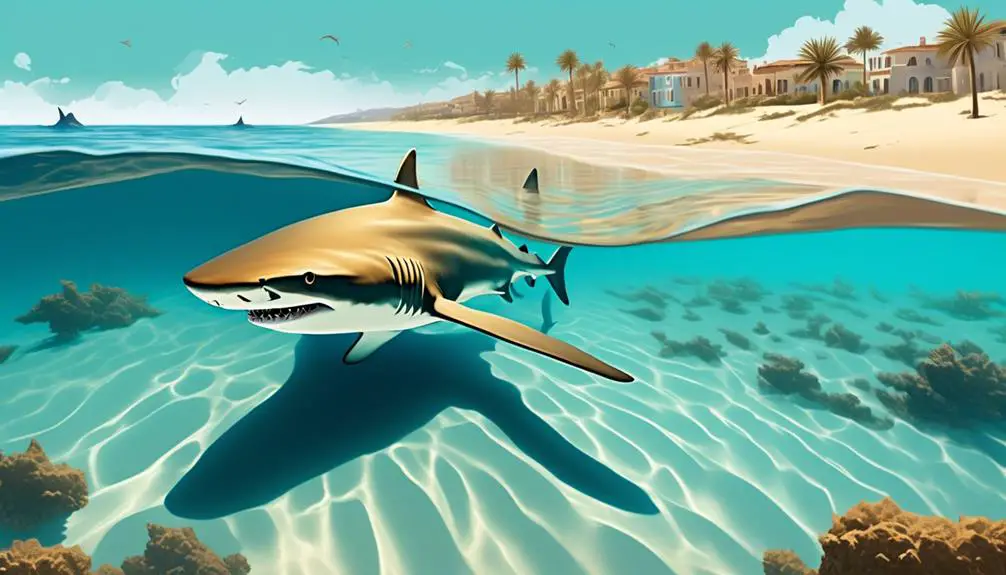Curious about the creatures lurking beneath the Mediterranean’s mesmerizing waves? Well, wonder no more. The Mediterranean Sea is home to a variety of shark species, both common and lesser-known. From the mighty Great White Shark to the mysterious Blue Shark, these fascinating creatures roam the depths, but are they a threat to your seaside adventures?
We’ll explore the dangers, conservation efforts, and delve into the enigmatic lives of these Mediterranean sharks. So, brace yourself for a deep dive into the captivating world of sharks in the Mediterranean Sea.
Blue Shark: Common Characteristics and Distribution
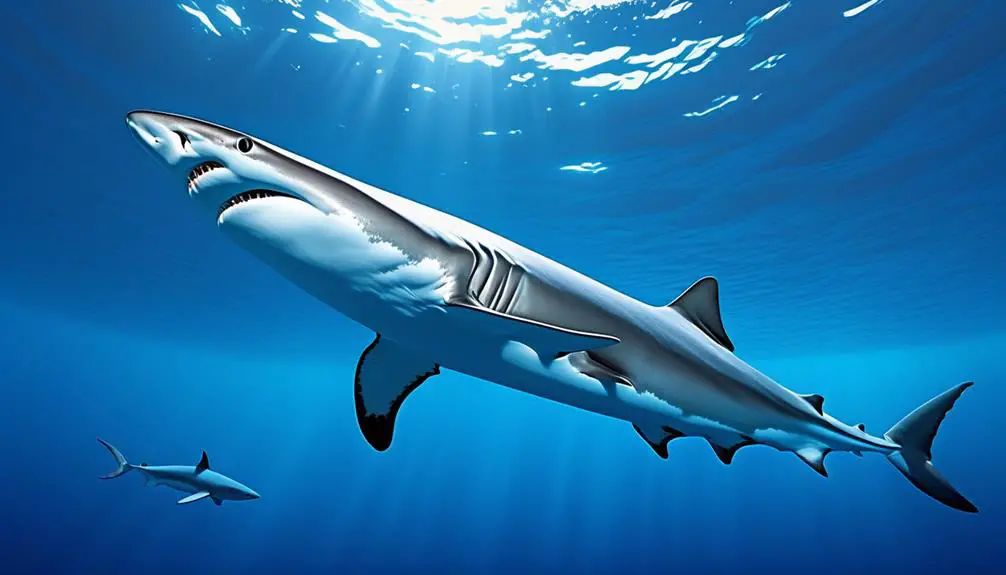
The blue shark, one of the most common shark species in the Mediterranean Sea, exhibits distinct characteristics and has a wide distribution throughout the region. This species, also known as Prionace glauca, can be found in deeper, slightly cooler waters and is frequently sighted in countries such as Spain, France, and Greece. Despite its prevalence, attacks on humans by the blue shark are infrequent.
Reproduction is a notable aspect of the blue shark’s life cycle. These sharks reach sexual maturity at a young age and can deliver a litter of up to 135 pups. This prolific breeding contributes to their widespread presence in the Mediterranean Sea.
However, it’s important to note that the blue shark’s behavior isn’t well understood, as it primarily dwells in the open ocean and migrates over long distances.
Great White Shark: Rare Sightings and Potential Nursery
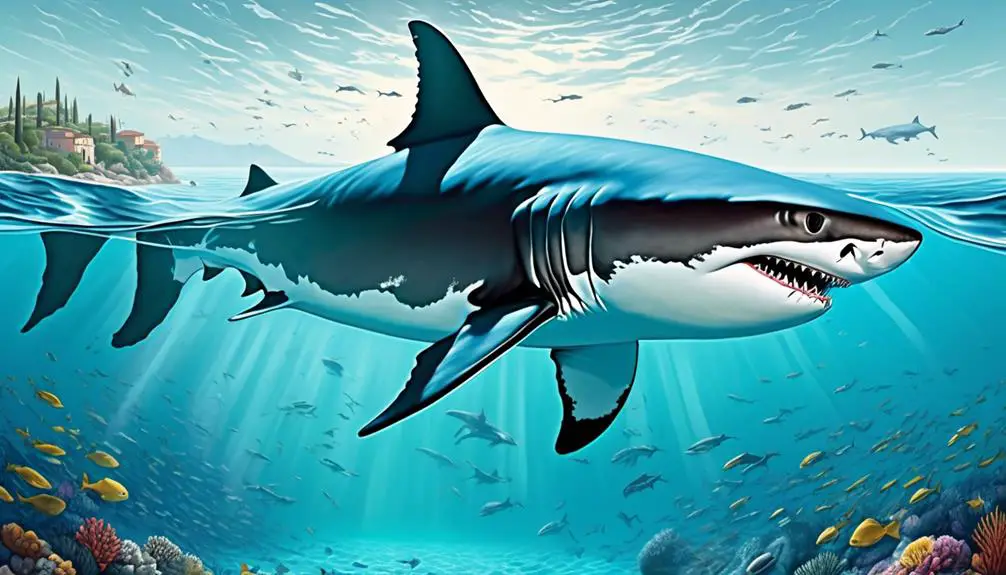
Great white sharks are known for their rarity in the Mediterranean Sea, making sightings of these apex predators a remarkable event.
However, there have been occasional reports of great white shark sightings in this region, suggesting that they may use the Mediterranean as a potential nursery ground for their young.
The presence of these iconic sharks in the Mediterranean raises intriguing questions about their behavior and reproductive strategies in this unique environment.
Rare Mediterranean Sightings
Rarely spotted but still a subject of fascination, the Mediterranean Sea occasionally offers glimpses of the elusive great white shark, potentially using the region as a nursery for their young.
While sightings of great white sharks in the Mediterranean are rare, there have been some documented occurrences. These sightings suggest that the Mediterranean may serve as a nursery for juvenile great white sharks, providing them with the necessary resources and protection during their early stages of life.
The exact reasons for these rare sightings and potential nursery behavior aren’t yet fully understood, but it’s believed that the unique environmental conditions and prey availability in the Mediterranean Sea may attract these apex predators.
Further research is needed to gain a deeper understanding of the behavior and ecology of great white sharks in the Mediterranean.
Mediterranean Nursery Grounds
Occasionally glimpsed in the Mediterranean Sea, the great white shark has been the subject of fascination due to its potential use of the region as a nursery for their young. While rare sightings of great white sharks have been reported, their presence in the Mediterranean as a nursery ground is still uncertain.
The Mediterranean Sea provides suitable conditions for shark reproduction, with its warm waters and abundant prey. However, the lack of concrete evidence and limited research make it challenging to confirm the Mediterranean as a nursery ground for great white sharks. Further scientific studies are needed to assess the reproductive behavior and habitat preference of these apex predators in the Mediterranean Sea.
Understanding the potential nursery grounds of great white sharks is crucial for their conservation and management in the region.
Blacktip Shark: Presence and Migration Patterns
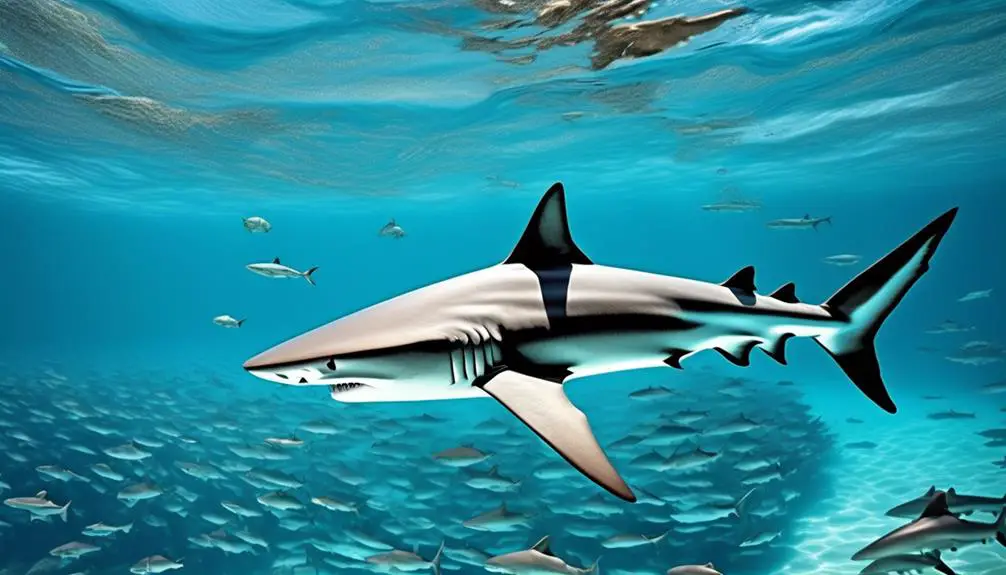
The blacktip shark is commonly seen in the Mediterranean Sea, particularly in the Eastern Med around Israel and Egypt. It exhibits migration patterns that contribute to its presence in the region. However, its behavior and potential threats to humans are currently not well-documented. As a result, conservation efforts for the blacktip shark in the Mediterranean are limited. The lack of information on its behavior and population status hinders effective conservation strategies.
Migration Patterns and Behavior
Blacktip sharks exhibit distinct presence and migration patterns in the Mediterranean Sea. These sharks are commonly seen in the Eastern Mediterranean, particularly around Israel and Egypt. They prefer shallow waters and are known for their migratory behavior.
Blacktip sharks undertake seasonal migrations, moving towards warmer waters in the summer months and returning to cooler waters in the winter. This pattern is influenced by factors such as temperature, prey availability, and reproductive needs. During their migration, blacktip sharks may cover long distances, traveling hundreds of kilometers.
Their behavior during migration is largely unknown, and there’s no available information regarding any threats they may pose to humans. Further research is needed to understand the specific migration patterns and behavior of blacktip sharks in the Mediterranean Sea.
Threats and Conservation Status
As we shift our focus to the subtopic of ‘Threats and Conservation Status’ concerning the blacktip shark, let’s explore its presence and migration patterns in the Mediterranean Sea.
The blacktip sharks are commonly seen in the Mediterranean, particularly in the Eastern Med around Israel and Egypt. Their presence is attributed to their migration patterns, although specific details about their behavior and threats to humans are currently unknown.
It’s important to note that blacktip sharks haven’t been reported as a significant threat to humans in the Mediterranean Sea. However, it’s crucial to continue monitoring their population and behavior to ensure their conservation and the safety of marine ecosystems.
Further research and conservation efforts are needed to better understand the threats faced by blacktip sharks in the Mediterranean Sea.
Endangered and Vulnerable Sharks in the Mediterranean Sea
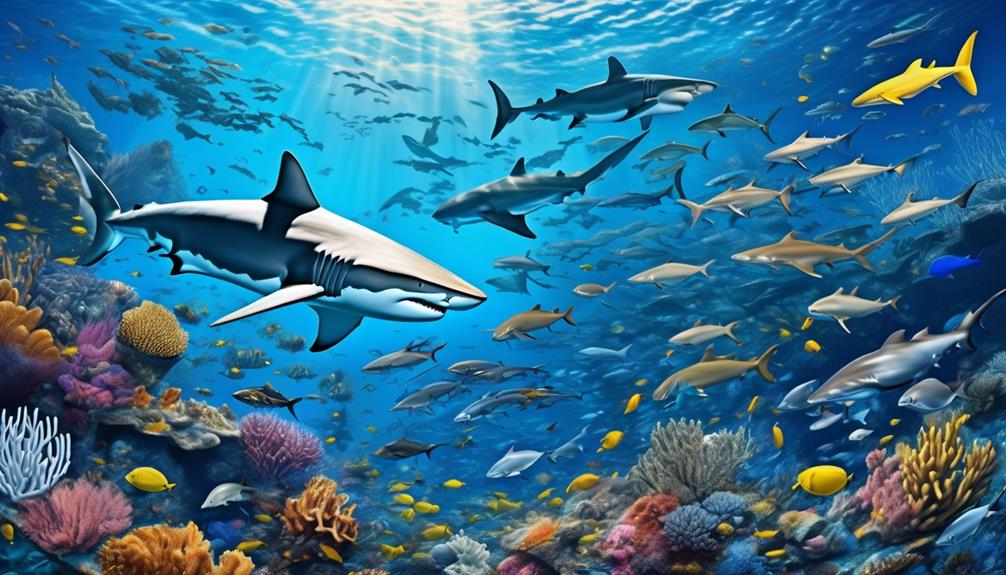
Endangered and vulnerable species of sharks can be found in the Mediterranean Sea, facing threats such as overfishing and habitat degradation.
One such species is the smalltooth sand tiger shark, which annually gathers at Shark Point in Beirut. The purpose of this gathering is unclear, but these sharks aren’t dangerous to humans. However, confusion with the more common grey nurse shark has led to their protection.
The grey nurse shark, known for its slow-moving and docile nature, isn’t aggressive towards humans. It’s considered a vulnerable species in the Mediterranean and primarily active at night, feeding on crustaceans and bottom-dwelling fish.
The hammerhead shark, represented by three species in the Mediterranean, including the great hammerhead, smooth hammerhead, and scalloped hammerhead, are aggressive apex predators. Overfishing has led to two of these species being endangered and one being vulnerable.
It’s imperative to address these threats and implement conservation measures to protect these endangered and vulnerable shark species in the Mediterranean Sea.
Other Sharks in the Mediterranean Sea
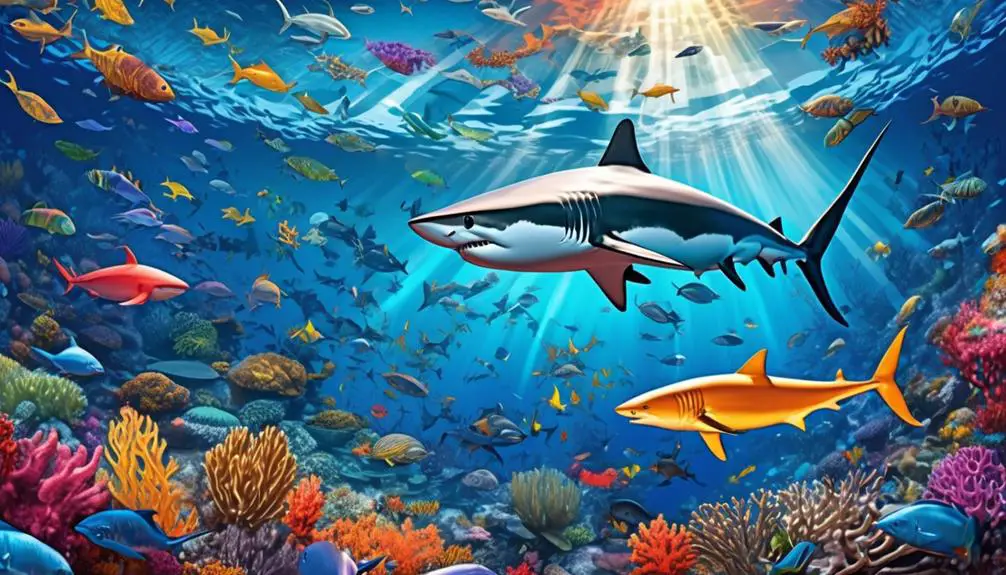
The Mediterranean Sea is home to a diverse range of shark species, in addition to the endangered and vulnerable ones discussed earlier. One of these species is the catshark, which includes three different species found in the Mediterranean: the Atlantic catshark, black-mouth catshark, and small-spotted catshark. These sharks have slender bodies with a soft dorsal fin set back towards their tail and can grow up to 3 feet long. Despite their appearance, catsharks are harmless to humans and pose no threat. Conservation efforts in Malta are being implemented to protect these sharks and ensure their survival.
Another shark species found in the Mediterranean is the shortfin mako shark. Known for their speed and elegance, these sharks have been declining in population due to overfishing and being targeted by game fishers. Interestingly, some of the largest specimens of shortfin mako sharks have been found in the Mediterranean Sea. Efforts must be made to conserve and protect these magnificent creatures to prevent their further decline.
Lastly, the spinner shark is also present in the Mediterranean Sea. Often mistaken for the blacktip shark, spinner sharks reside in warm and shallow waters. They aren’t a threat to humans and pose no danger. However, spinner sharks are considered a vulnerable species and are facing fishing bans in North America to safeguard their population.
Shark Attacks in the Mediterranean Sea

Shark attacks in the Mediterranean Sea, although rare, have been documented over the years. Italy has the highest number of unprovoked shark attacks, with 26 incidents since 1900. However, it’s important to note that most sharks in the Mediterranean Sea are harmless, and the sea isn’t shark-infested. The Mediterranean Sea is generally safe for swimming, with few dangers. While great white sharks are considered the most dangerous sharks in the world, sightings of them in the Mediterranean are rare.
It is crucial to understand that shark attacks are uncommon occurrences in the Mediterranean Sea. The few incidents that have been reported are isolated and don’t reflect a significant threat to human safety. Nonetheless, it’s always prudent to be aware of one’s surroundings and adhere to safety guidelines when swimming or engaging in water activities.
The rarity of shark attacks in the Mediterranean can be attributed to various factors. The presence of a diverse range of marine life, including different species of sharks, contributes to a balanced ecosystem that minimizes encounters between sharks and humans. Additionally, the Mediterranean’s warm and shallow waters aren’t typically favored by sharks known for unprovoked attacks, such as the great white shark.
It is crucial to approach the topic of shark attacks in the Mediterranean Sea with objectivity, focusing on scientific data and evidence. By doing so, we can provide accurate information to the public and dispel any misconceptions or fears about shark encounters in this region.
Conservation and Threats to Mediterranean Sharks
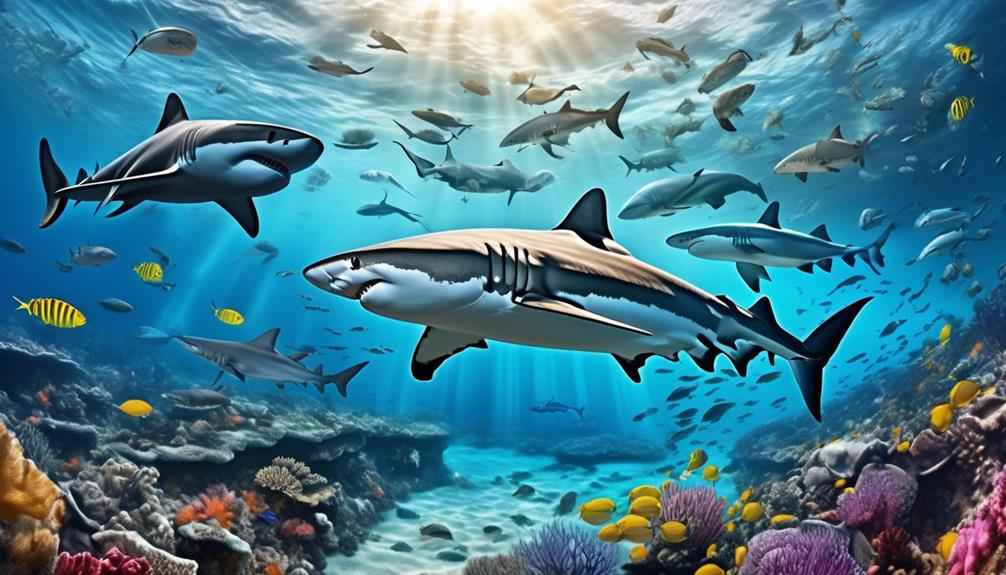
While the Mediterranean Sea is generally safe for swimming, it is important to address the conservation and threats facing the diverse shark species within its waters. Some of the key conservation and threat issues for Mediterranean sharks are summarized in the table below:
| Conservation and Threats to Mediterranean Sharks |
|---|
| Overfishing |
| Targeted by game fishers |
| Declining populations |
| Vulnerable and endangered species |
Overfishing is a significant threat to Mediterranean sharks, particularly for species like the smalltooth sand tiger shark, hammerhead sharks, and mako sharks. These species are already endangered or vulnerable due to excessive fishing. Additionally, the declining population of shortfin mako sharks is a concern, as they are targeted by game fishers for their sport and trophy value.
Conservation efforts are being made in Malta to protect catsharks, which are found in the Mediterranean Sea. These efforts aim to safeguard these harmless sharks and ensure their survival in the region.
Grey nurse sharks, known for their slow-moving and docile nature, are considered a vulnerable species in the Mediterranean. They primarily feed on crustaceans and bottom-dwelling fish and are active at night.
Spinner sharks, often mistaken for blacktip sharks, are also vulnerable and face fishing bans in North America. These sharks reside in warm and shallow waters and pose no threat to humans.

Erzsebet Frey (Eli Frey) is an ecologist and online entrepreneur with a Master of Science in Ecology from the University of Belgrade. Originally from Serbia, she has lived in Sri Lanka since 2017. Eli has worked internationally in countries like Oman, Brazil, Germany, and Sri Lanka. In 2018, she expanded into SEO and blogging, completing courses from UC Davis and Edinburgh. Eli has founded multiple websites focused on biology, ecology, environmental science, sustainable and simple living, and outdoor activities. She enjoys creating nature and simple living videos on YouTube and participates in speleology, diving, and hiking.
- WILDLIFE THEMED T-SHIRTS
Cute Hedgehog Embroidered: Love Wildlife, Protect Nature Wildlife conservation tees
$35.00

